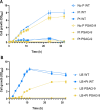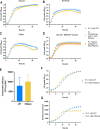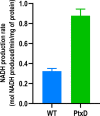Phosphite synthetic auxotrophy as an effective biocontainment strategy for the industrial chassis Pseudomonas putida
- PMID: 35934698
- PMCID: PMC9358898
- DOI: 10.1186/s12934-022-01883-5
Phosphite synthetic auxotrophy as an effective biocontainment strategy for the industrial chassis Pseudomonas putida
Abstract
The inclusion of biosafety strategies into strain engineering pipelines is crucial for safe-by-design biobased processes. This in turn might enable a more rapid regulatory acceptance of bioengineered organisms in both industrial and environmental applications. For this reason, we equipped the industrially relevant microbial chassis Pseudomonas putida KT2440 with an effective biocontainment strategy based on a synthetic dependency on phosphite, which is generally not readily available in the environment. The produced PSAG-9 strain was first engineered to assimilate phosphite through the genome-integration of a phosphite dehydrogenase and a phosphite-specific transport complex. Subsequently, to deter the strain from growing on naturally assimilated phosphate, all native genes related to its transport were identified and deleted generating a strain unable to grow on media containing any phosphorous source other than phosphite. PSAG-9 exhibited fitness levels with phosphite similar to those of the wild type with phosphate, and low levels of escape frequency. Beyond biosafety, this strategy endowed P. putida with the capacity to be cultured under non-sterile conditions using phosphite as the sole phosphorous source with a reduced risk of contamination by other microbes, while displaying enhanced NADH regenerative capacity. These industrially beneficial features complement the metabolic advantages for which this species is known for, thereby strengthening it as a synthetic biology chassis with potential uses in industry, with suitability towards environmental release.
Keywords: Biocontainment; NADH; Non-sterile conditions; Phosphite; Pseudomonas putida; Synthetic auxotrophy.
© 2022. The Author(s).
Conflict of interest statement
The authors declare no competing interest for this article.
Figures







Similar articles
-
Deletion of genomic islands in the Pseudomonas putida KT2440 genome can create an optimal chassis for synthetic biology applications.Microb Cell Fact. 2020 Mar 18;19(1):70. doi: 10.1186/s12934-020-01329-w. Microb Cell Fact. 2020. PMID: 32188438 Free PMC article.
-
Enhanced production of polyhydroxyalkanoates in Pseudomonas putida KT2440 by a combination of genome streamlining and promoter engineering.Int J Biol Macromol. 2022 Jun 1;209(Pt A):117-124. doi: 10.1016/j.ijbiomac.2022.04.004. Epub 2022 Apr 5. Int J Biol Macromol. 2022. PMID: 35395277
-
Pseudomonas putida as a synthetic biology chassis and a metabolic engineering platform.Curr Opin Biotechnol. 2024 Feb;85:103025. doi: 10.1016/j.copbio.2023.103025. Epub 2023 Dec 7. Curr Opin Biotechnol. 2024. PMID: 38061264 Review.
-
Pseudomonas putida as a functional chassis for industrial biocatalysis: From native biochemistry to trans-metabolism.Metab Eng. 2018 Nov;50:142-155. doi: 10.1016/j.ymben.2018.05.005. Epub 2018 May 16. Metab Eng. 2018. PMID: 29758287 Review.
-
Pseudomonas putida KT2440: the long journey of a soil-dweller to become a synthetic biology chassis.J Bacteriol. 2024 Jul 25;206(7):e0013624. doi: 10.1128/jb.00136-24. Epub 2024 Jul 8. J Bacteriol. 2024. PMID: 38975763 Free PMC article. Review.
Cited by
-
A roadmap to understanding and anticipating microbial gene transfer in soil communities.Microbiol Mol Biol Rev. 2025 Jun 25;89(2):e0022524. doi: 10.1128/mmbr.00225-24. Epub 2025 Apr 8. Microbiol Mol Biol Rev. 2025. PMID: 40197024 Review.
-
Design and regulation of engineered bacteria for environmental release.Nat Microbiol. 2025 Feb;10(2):281-300. doi: 10.1038/s41564-024-01918-0. Epub 2025 Feb 4. Nat Microbiol. 2025. PMID: 39905169 Review.
-
Exploring the Impact of Tensions in Stakeholder Norms on Designing for Value Change: The Case of Biosafety in Industrial Biotechnology.Sci Eng Ethics. 2023 Mar 7;29(2):9. doi: 10.1007/s11948-023-00432-6. Sci Eng Ethics. 2023. PMID: 36882674 Free PMC article.
-
The functional mechanisms of phosphite and its applications in crop plants.Front Plant Sci. 2025 Apr 7;16:1538596. doi: 10.3389/fpls.2025.1538596. eCollection 2025. Front Plant Sci. 2025. PMID: 40260435 Free PMC article. Review.
-
Genetic "expiry-date" circuits control lifespan of synthetic scavenger bacteria for safe bioremediation.Nucleic Acids Res. 2025 Jul 19;53(14):gkaf703. doi: 10.1093/nar/gkaf703. Nucleic Acids Res. 2025. PMID: 40705927 Free PMC article.
References
-
- Fernández M, Duque E, Pizarro-Tobías P, Van Dillewijn P, Wittich R, Ramos JL. Microbial responses to xenobiotic compounds. Identification of genes that allow Pseudomonas putida KT2440 to cope with 2,4,6-trinitrotoluene. Microb Biotechnol. 2009;2:287–294. doi: 10.1111/j.1751-7915.2009.00085.x. - DOI - PMC - PubMed
MeSH terms
Substances
Grants and funding
LinkOut - more resources
Full Text Sources
Other Literature Sources

